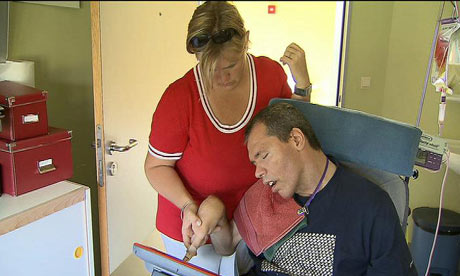World news | Belgium
Trapped in his own body for 23 years - the coma victim who screamed unheard
• Misdiagnosed man's tale of rebirth thanks to doctor
• Total paralysis masked fully functioning brain
Other falsely diagnosed coma cases
 Rom Houben, 46, was diagnosed as being in a vegetative state after an accident in his 20s but can now communicate by computer keyboard. Photograph: VTM Belgium For 23 years Rom Houben was imprisoned in his own body. He saw his doctors and nurses as they visited him during their daily rounds; he listened to the conversations of his carers; he heard his mother deliver the news to him that his father had died. But he could do nothing. He was unable to communicate with his doctors or family. He could not move his head or weep, he could only listen.
Rom Houben, 46, was diagnosed as being in a vegetative state after an accident in his 20s but can now communicate by computer keyboard. Photograph: VTM Belgium For 23 years Rom Houben was imprisoned in his own body. He saw his doctors and nurses as they visited him during their daily rounds; he listened to the conversations of his carers; he heard his mother deliver the news to him that his father had died. But he could do nothing. He was unable to communicate with his doctors or family. He could not move his head or weep, he could only listen.Doctors presumed he was in a vegetative state following a near-fatal car crash in 1983. They believed he could feel nothing and hear nothing. For 23 years.
Then a neurologist, Steven Laureys, who decided to take a radical look at the state of diagnosed coma patients, released him from his torture. Using a state-of-the-art scanning system, Laureys found to his amazement that his brain was functioning almost normally.
"I had dreamed myself away," said Houben, now 46, whose real "state" was discovered three years ago, according to a report in the German magazine Der Spiegel this week.
Laureys, a neurologist at the University of Liege in Belgium, published a study in BMC Neurology earlier this year saying Houben could be one of many cases of falsely diagnosed comas around the world. He discovered that although Houben was completely paralysed, he was also completely conscious — it was just that he was unable to communicate the fact.
Houben now communicates with one finger and a special touchscreen on his wheelchair – he has developed some movement with the help of intense physiotherapy over the last three years.
He realised when he came round after his accident, which had caused his heart to stop and his brain to be starved of oxygen for several minutes, that his body was paralysed. Although he could hear every word his doctors spoke, he could not communicate with them.
"I screamed, but there was nothing to hear," he said, via his keyboard.
The Belgian former engineering student, who speaks four languages, said he coped with being effectively trapped in his own body by meditating. He told doctors he had "travelled with my thoughts into the past, or into another existence altogether". Sometimes, he said, "I was only my consciousness and nothing else".
The moment it was discovered he was not in a vegetative state, said Houben, was like being born again. "I'll never forget the day that they discovered me," he said. "It was my second birth".
Experts say Laureys' findings are likely to reopen the debate over when the decision should be made to terminate the lives of those in comas who appear to be unconscious but may have almost fully-functioning brains.
Belgian doctors used an internationally-accepted scale to monitor Houben's state over the years. Known as the Glasgow Coma Scale, it requires assessment of the eyes, verbal and motor responses. But they failed to assess him correctly and missed signs that his brain was still functioning.
Last night his mother, Fina, said in an interview with Belgian RTBF that they had taken him to the US five times for reexamination. The breakthrough came when it became clear that Houben could indicate yes and no with his foot.
"Powerlessness. Utter powerlessness. At first I was angry, then I learned to live with it," he tapped out on to the screen during an interview with the Belgian network last night, AP reported.
Laureys, who is head of the Coma Science Group and department of neurology at Liege University hospital, has advised on several prominent coma cases, such as the American Terri Schiavo, whose life support was withdrawn in 2005 after 15 years in a coma.
Laureys concluded that coma patients are misdiagnosed "on a disturbingly regular basis". He examined 44 patients believed to be in a vegetative state, and found that 18 of them responded to communication.
"Once someone is labelled as being without consciousness, it is very hard to get rid of that," he told Der Spiegel.
He said patients suspected of being in a non-reversible coma should be "tested 10 times" and that comas, like sleep, have different stages and need to be monitored.
Houben hopes to write a book detailing his trauma and his "rebirth".

What an amazing story!! Frightening also because of the implications of being misdiagnosed and spending your life trapped in a non functioning body. A valuable lesson here is that Rom managed to survive this trauma and keep his sanity by using meditation to explore his consciousness and discover that we are more than our bodies...
ReplyDelete